Abstract
Anorectal manometry and sphincter electromyography were performed in 23 patients with complete supraconal traumatic spinal injuries and 30 age and sex matched control subjects. Basal pressures in the spinal group were similar to those in normal subjects but conscious control of sphincter activity was abolished in all spinal patients. Discriminant rectal sensation was also abolished during rectal distension, but 40% of patients experienced a dull pelvic ache at maximum levels of distension. Phasic rectal contraction and anal relaxation were present but exaggerated and induced at lower distending volumes than in normal subjects. The configuration of the rectal pressure/volume relationship was linear in patients compared with a reversed 'S' shape in normal subjects. The external anal sphincter response to rectal distension was noticeably attenuated, reinforcing the view that this spinal reflex is heavily modulated by supraspinal centres under normal circumstances. The external anal sphincter response to increases in abdominal pressure was also attenuated, and the anal pressures were strongly correlated with the level of the lesion and the abdominal pressure the patient could generate. No spinal patient showed a decrease in external anal sphincter activity during straining 'as if to defecate.' The exaggerated anorectal smooth muscle responses to rectal distension and the attenuated external sphincter response explain why patients with complete supraconal spinal lesions experience uncontrollable reflex defecation, while the persistance of external and sphincter contraction and the absence of any external anal sphincter relaxation during straining 'as if to defecate' might explain the difficulty that these patients have in consciously expelling rectal contents.
Full text
PDF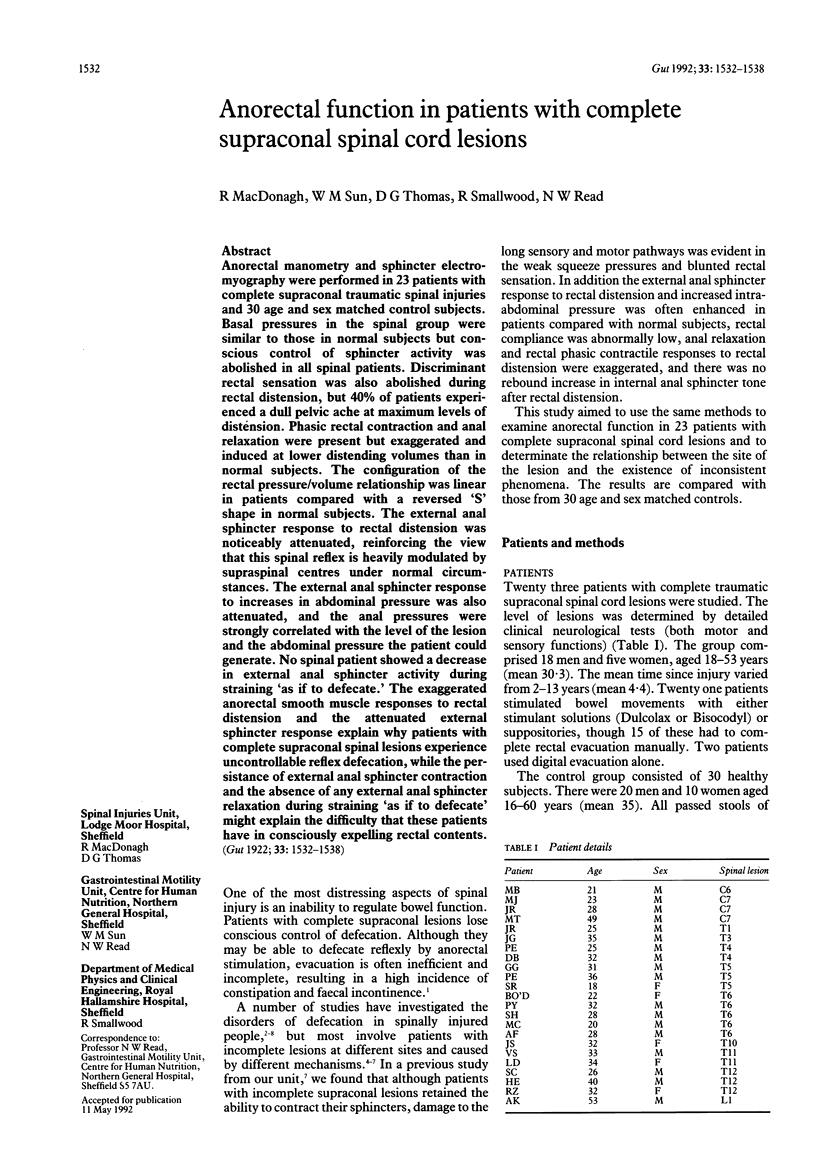

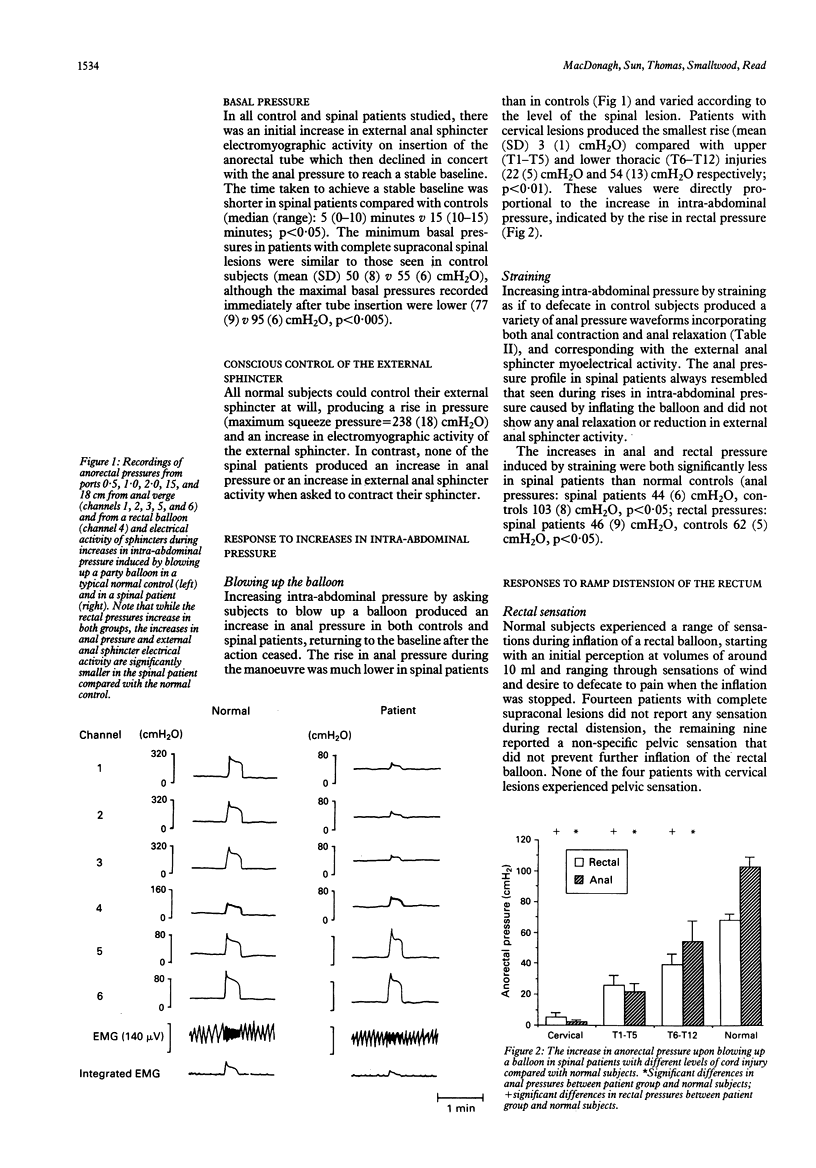
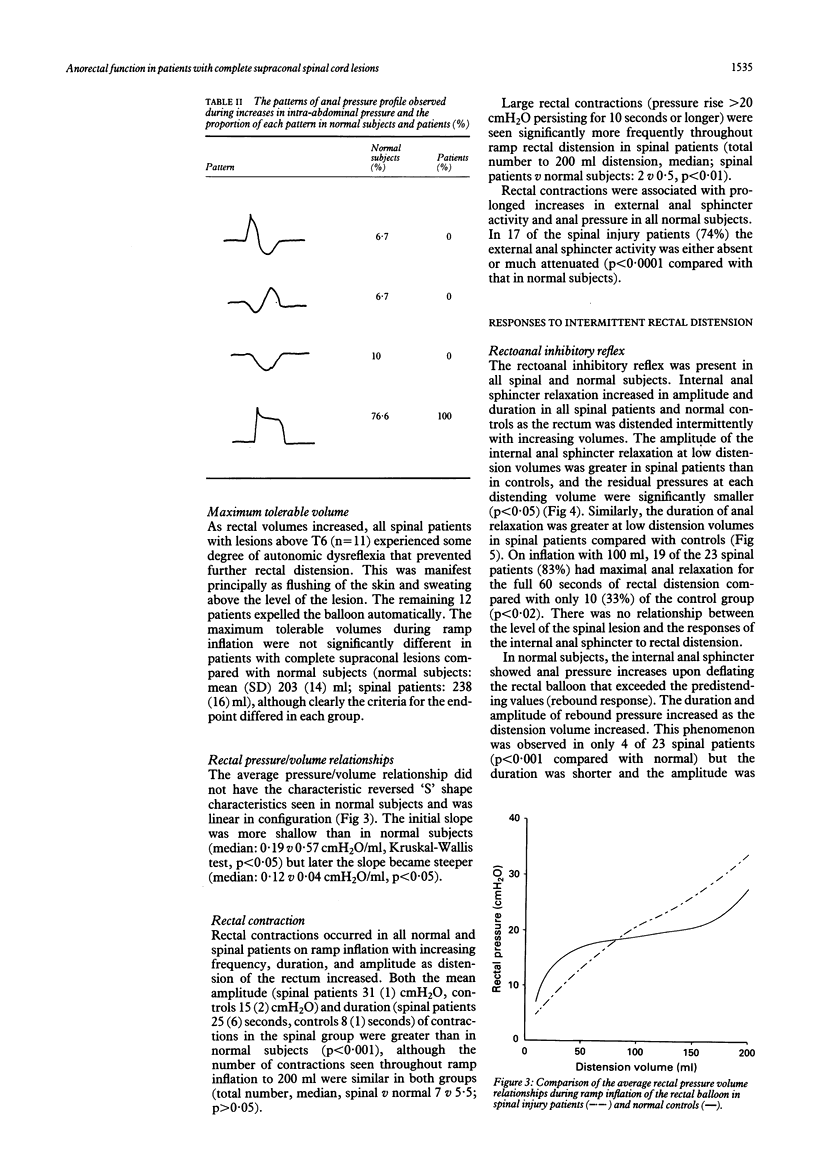
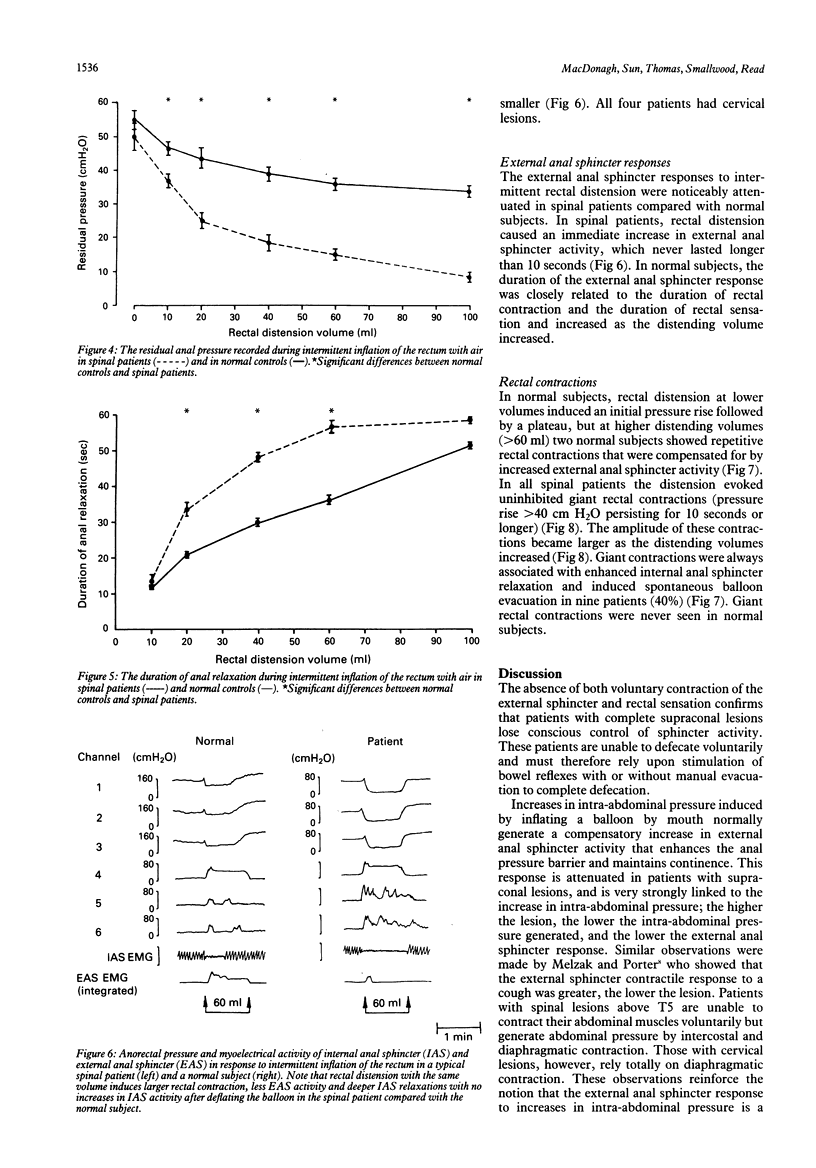
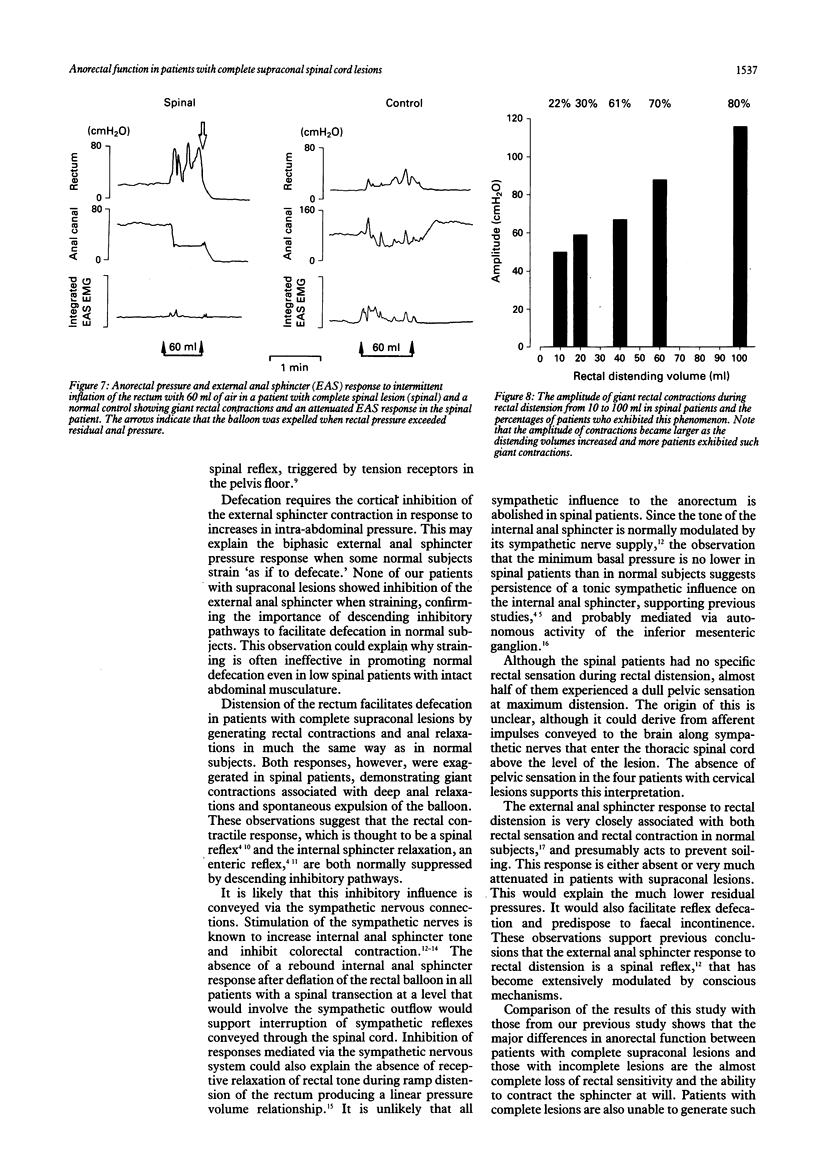
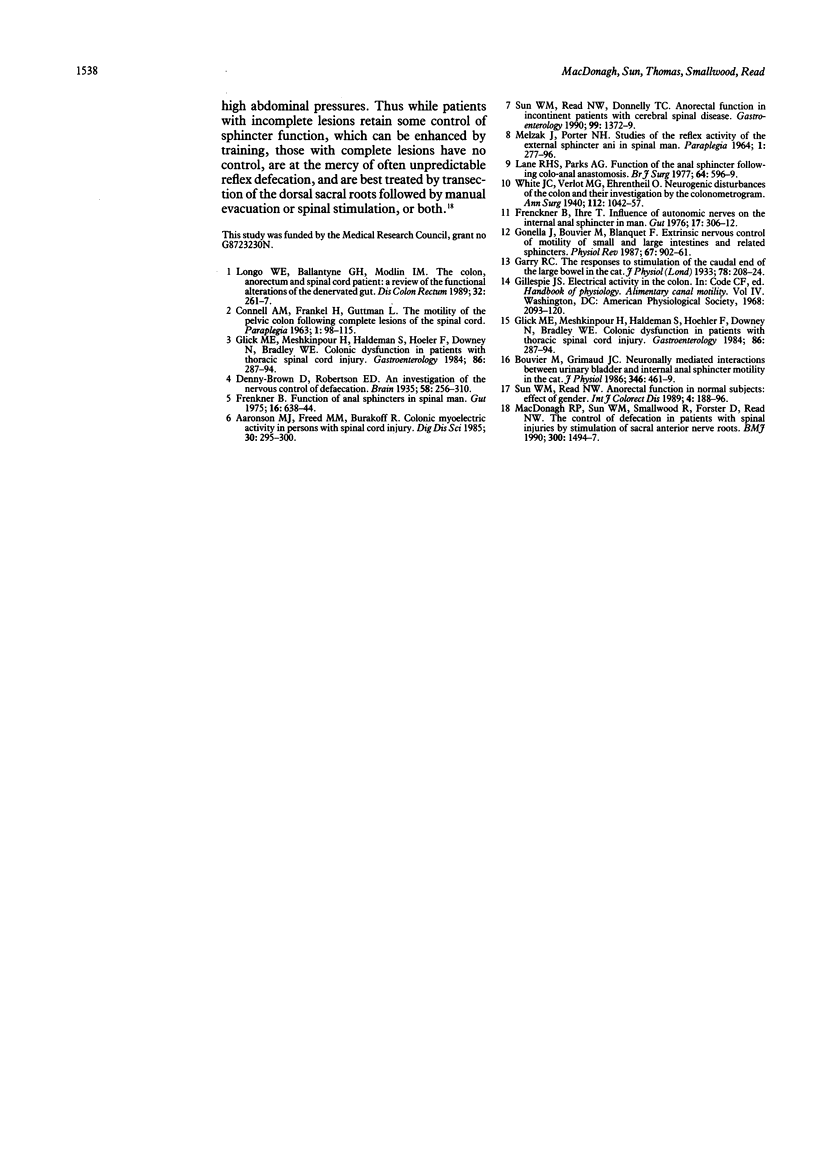
Selected References
These references are in PubMed. This may not be the complete list of references from this article.
- Aaronson M. J., Freed M. M., Burakoff R. Colonic myoelectric activity in persons with spinal cord injury. Dig Dis Sci. 1985 Apr;30(4):295–300. doi: 10.1007/BF01403836. [DOI] [PubMed] [Google Scholar]
- Bouvier M., Grimaud J. C. Neuronally mediated interactions between urinary bladder and internal anal sphincter motility in the cat. J Physiol. 1984 Jan;346:461–469. doi: 10.1113/jphysiol.1984.sp015035. [DOI] [PMC free article] [PubMed] [Google Scholar]
- CONNELL A. M., FRANKEL H., GUTTMANN L. THE MOTILITY OF THE PELVIC COLON FOLLOWING COMPLETE LESIONS OF THE SPINAL CORD. Paraplegia. 1963 Sep;1:98–115. doi: 10.1038/sc.1963.9. [DOI] [PubMed] [Google Scholar]
- Frenckner B. Function of the anal sphincters in spinal man. Gut. 1975 Aug;16(8):638–644. doi: 10.1136/gut.16.8.638. [DOI] [PMC free article] [PubMed] [Google Scholar]
- Frenckner B., Ihre T. Influence of autonomic nerves on the internal and sphincter in man. Gut. 1976 Apr;17(4):306–312. doi: 10.1136/gut.17.4.306. [DOI] [PMC free article] [PubMed] [Google Scholar]
- Garry R. C. The responses to stimulation of the caudal end of the large bowel in the cat. J Physiol. 1933 May 23;78(2):208–224. doi: 10.1113/jphysiol.1933.sp002998. [DOI] [PMC free article] [PubMed] [Google Scholar]
- Glick M. E., Meshkinpour H., Haldeman S., Hoehler F., Downey N., Bradley W. E. Colonic dysfunction in patients with thoracic spinal cord injury. Gastroenterology. 1984 Feb;86(2):287–294. [PubMed] [Google Scholar]
- Glick M. E., Meshkinpour H., Haldeman S., Hoehler F., Downey N., Bradley W. E. Colonic dysfunction in patients with thoracic spinal cord injury. Gastroenterology. 1984 Feb;86(2):287–294. [PubMed] [Google Scholar]
- Gonella J., Bouvier M., Blanquet F. Extrinsic nervous control of motility of small and large intestines and related sphincters. Physiol Rev. 1987 Jul;67(3):902–961. doi: 10.1152/physrev.1987.67.3.902. [DOI] [PubMed] [Google Scholar]
- Lane R. H., Parks A. G. Function of the anal sphincters following colo-anal anastomosis. Br J Surg. 1977 Aug;64(8):596–599. doi: 10.1002/bjs.1800640820. [DOI] [PubMed] [Google Scholar]
- Longo W. E., Ballantyne G. H., Modlin I. M. The colon, anorectum, and spinal cord patient. A review of the functional alterations of the denervated hindgut. Dis Colon Rectum. 1989 Mar;32(3):261–267. doi: 10.1007/BF02554543. [DOI] [PubMed] [Google Scholar]
- MELZAK J., PORTER N. H. STUDIES OF THE REFLEX ACTIVITY OF THE EXTERNAL SPHINCTER ANI IN SPINAL MAN. Paraplegia. 1964 Mar;1:277–296. doi: 10.1038/sc.1963.25. [DOI] [PubMed] [Google Scholar]
- MacDonagh R. P., Sun W. M., Smallwood R., Forster D., Read N. W. Control of defecation in patients with spinal injuries by stimulation of sacral anterior nerve roots. BMJ. 1990 Jun 9;300(6738):1494–1497. doi: 10.1136/bmj.300.6738.1494. [DOI] [PMC free article] [PubMed] [Google Scholar]
- Sun W. M., Read N. W. Anorectal function in normal human subjects: effect of gender. Int J Colorectal Dis. 1989 Aug;4(3):188–196. doi: 10.1007/BF01649702. [DOI] [PubMed] [Google Scholar]
- Sun W. M., Read N. W., Donnelly T. C. Anorectal function in incontinent patients with cerebrospinal disease. Gastroenterology. 1990 Nov;99(5):1372–1379. doi: 10.1016/0016-5085(90)91164-2. [DOI] [PubMed] [Google Scholar]
- White J. C., Verlot M. G., Ehrentheil O. NEUROGENIC DISTURBANCES OF THE COLON AND THEIR INVESTIGATION BY THE COLONMETROGRAM: A PRELIMINARY REPORT. Ann Surg. 1940 Dec;112(6):1042–1057. doi: 10.1097/00000658-194012000-00004. [DOI] [PMC free article] [PubMed] [Google Scholar]


